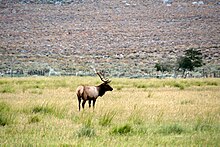California coastal prairie
[7] This ecosystem can also be characterized by topographic features including sea bluffs, uplifted grassy bald hills, hillside slopes, lowland grasslands, and coastal marine terraces.
[10] Disruptive factors such as wind, fire, salt spray, digging, and grazing help to maintain more open (as well as healthy) grasslands; for example, they are crucial to facilitating the release of nutrients, stimulating microbial activity, and regulating competition between woody and herbaceous plants.
While these efforts are well-intended, the removal of grazers from this ecosystem rids it of the disturbance it requires, and is therefore thought to be responsible for such metrics as worsening soil quality and declining annual wildflower blooms in these areas.
[13] In the absence of frequent fires—especially controlled burns—and many once-prominent grazing and burrowing species that evolved within this ecosystem, much of what is left of the California coastal prairie is being lost to shrub and tree encroachment.
[18] Characteristic species of this community include:[19] The entire coastal prairie biome can be completely restored, even after the plants seem to have disappeared for decades after grazing end, by unearthing their dormant native seeds in the soil, that are still viable underneath the weeds.
Between 1992 and 2000, at 300 Byers Lane, La Selva Beach in Santa Cruz County, 70 acres of habitat went from 99% weed-covered to 95% native covered in only eight years, without sowing any seeds.
[25] Coastal Prairies of California are classified as critically endangered with the following stressors causing the most impacts: invasive species, low nutrient soils, urbanization, and unregulated recreational activities.
[26] Debates remain on how to apply conservancy efforts to Californian coastal prairies, in balancing disturbances to allow for the flourishing of the native plants as well as quality pasture for grazers.

